When we first met, Bernie had no interest in garden birds. He professes never to have noticed a single bird. These days he takes on the task of cleaning out and siting our bird boxes and earlier this year he devoted significant time to constructing and trialling protection for last year’s swallows’ nest in which, very sadly, the three babies drowned during a downpour. (We have swallows nesting again now. We’re hoping for a happier ending this year.)
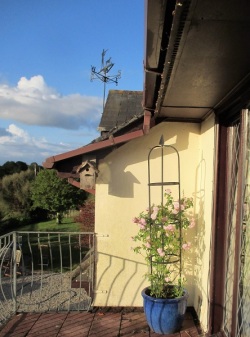
One of the boxes we inherited is positioned on our balcony, just a yard from the large, opening glass doors into the living room. Old and battered, it has never had occupants since we’ve been here and I suggested it might be reappointed elsewhere. B chose to repair it a little and hang it back in the same spot. Birds prefer their boxes to be facing south-east. This one faces north-west. It seemed to have nothing in its favour. But this year it has had occupants!
Would they, wouldn’t they? We watched the great tits coming and going, bringing in the occasional piece of nesting material but never frequently enough to convince us they would stay. Were they laying? All the way along I maintained that they would never succeed; the box is so close to the house; it’s facing the wrong way… I was wrong.
Soon they were back and forth, bringing in caterpillars. Gradually the noises inside the box grew louder and more insistent. And now they have fledged. As we watched the drama unfold, I realised – not for the first time – how little I know. Great tits are such a familiar sight in our British gardens, yet I realise that like Bernie, I’ve not really looked at them before.
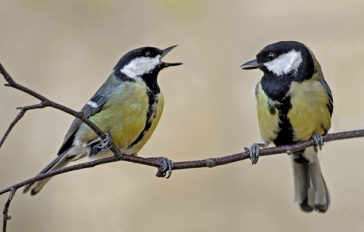
Now I know that there is a difference between the sexes, with males having a broader and longer black chest stripe. It is just the female who constructs the nest and she generally lays an egg a day, early in the morning, which she covers with nesting material before spending the day with her mate and returning to roost in the evening. The male assists by feeding her, contributing up to a third of the food she needs. We watched her begging for food as a youngster might and being fed by her mate. Now we know that this help is much needed as each egg she lays will be approximately 10% of her weight so by the time her clutch is complete, it may weigh more than she does herself.
Incubation does not begin until the final egg has been laid. This explains why it seemed to us that incubation went on for so long. Chicks weigh about 1.5g on hatching and between 16-26g when they fledge. That’s a massive growth spurt! In a woodland setting, the parents can expect to deliver 10,000 caterpillars to their growing chicks. In gardens, there will be fewer caterpillars so the diet must vary and successful rearings are reduced. We are very rural with many oak trees close by. We watched as many caterpillars entered the box and as the days passed, the adults also took food from the feeders into the nest. To begin with the adults vanished entirely inside. As time went on their tails remained progressively visible. There was less room inside the box; the chicks were growing.
One day I realised why this might be the year that the box has been used. Until last summer our feeders have always been on the balcony. This spring we moved them down into the garden, leaving just two peanut feeders hanging one each end of the balcony. One hung just a foot away from the great tits’ box. As they continued to feed the youngsters, the parents began chasing off any small birds who attempted to use it. And what a commotion they made when the woodpeckers settled! Too small to frighten them off, the angry great tits kept up a racket so noisy that we found ourselves rushing out to chase away the woodpeckers on their behalf! It was then it came to me that maybe I could just remove that feeder… It worked; life was much less stressful for the parents.
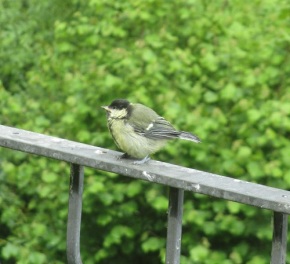
One evening there was a fat, fluffy great tit wobbling on the balcony railings.
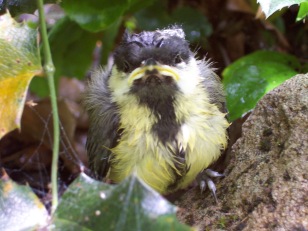
And the next morning the box was silent. They had gone.
But not entirely.
We are quite convinced that ‘our babies’ have returned several times along with their parents. The noise is unmistakable: several fledglings at a time fluttering their tiny wings and begging, whilst their devoted parent offers titbits. These photos are mine, taken through the glass with my usual lack of skill and patience. I’m rather proud of them!
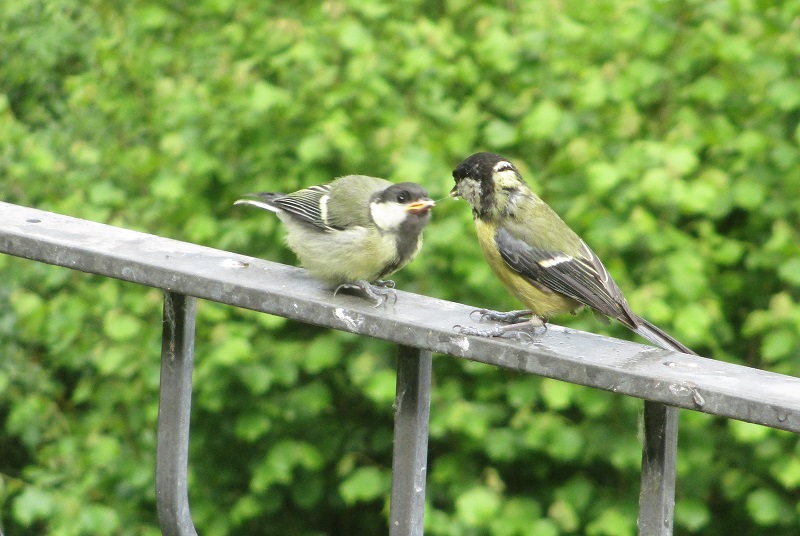
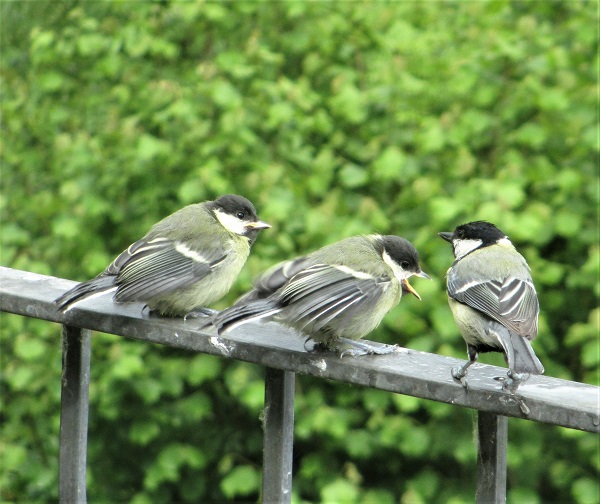
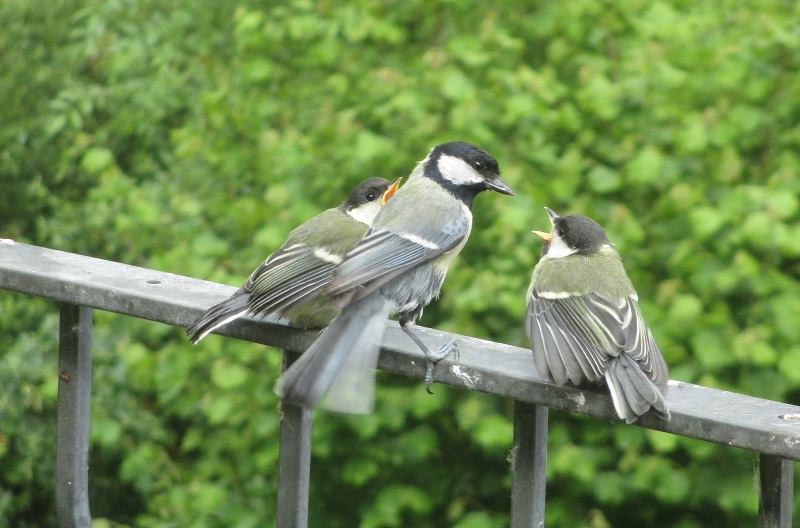
The most recent visit was a day or so ago. One feeder is still on the balcony floor at the moment. (The balcony, from which the cats are banned, is quite a safe place for birds.) Three youngsters waited, begging loudly. The parent settled; had its fill and flew away. The youngsters stood silent and motionless. Forgive me for anthropomorphising, but I immediately thought of outraged teenagers. Seconds passed. Then one by one, they hopped onto the feeder themselves. Fledglings are independent of the parent after 8 days but parental feeding may continue for much longer. This parent clearly needed a break!
There is a good chance the pair will return to breed on the balcony again next year. I hope so.
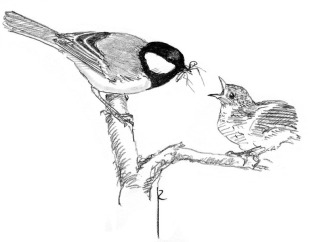



What a lovely story, and what a privilege to witness this little family breed and successfully fledge. Great photos too. We have had a family of blackbirds nesting in the barn our three households use for storage. The mess from their droppings is indescribable. Have we evicted them? Of course not!
LikeLiked by 2 people
Our great tits have been very tidy. The swallows on the other hand…. 🤷
LikeLiked by 1 person
Mmm. We know……
LikeLiked by 1 person
An exciting story of new life. None of our boxes get used – but sparrows regularly nest in a rusty old burglar alarm, and starlings in the eaves. Sad about last year’s swallows. Judging by what we are learning the shelter is really needed this year. Hope it dries out for you soon
LikeLiked by 2 people
We have more unused boxes than used ones, Derrick; birds clearly make their own choices – and why not! This year we put up a swanky new triple-box allegedly for sparrows. Not a flicker of interest!
LikeLiked by 1 person
What a good story! We had blue tits nesting in the garden last year and they started building this year but after a bit of a fracas with another blue tit it went quiet. Goldfinches still appear to strip the pampas grass though. Your post was full of interesting facts. It’s lovely to take note of a particular species and learn more.
LikeLiked by 1 person
I’m constantly caught out by how little I know about the wildlife which is all around us. Sometimes a little nudge can open up worlds of knowledge 🙂
LikeLiked by 1 person
What a great story – and thanks for all the educational points about blue tits. I’d love a nest box in my garden but we’re too urban and there are tonnes of cats around here.
LikeLiked by 1 person
Urban isn’t likely to be a problem but cats are tricky. We have two. It’s a challenge finding safe spots for the nest boxes and once the young have fledged there is always a risk. Since writing this post I have counted 9 – 11 fledglings feeding on the safe balcony at any one time. So I think we’re beating the battle with the felines!
LikeLike
What a privilege to see these birds so close. I must think about putting up a nest box or two, but the neighbour’s cats come through my garden so I need a safe place. I have kept the sunflower seeds out this year as the birds are still feeding and we were amused to see a parent sparrow bring its baby to the feeder with much fluttering of wings and see it popping seeds into the open mouth.
LikeLiked by 1 person
It really is a privilege, Jude. The young are still visiting (this post was written last week) and I’ve now counted up to 11 youngsters at a time so Mr & Mrs Great Tit did a good job. But yes – finding a safe spot for a nest box is crucial.
LikeLiked by 2 people
Gorgeous! Glad to hear that the birds are safe from the cats, too.
LikeLiked by 1 person
Rose, the youngsters continue to visit and I’ve counted between 9 – 11 at any one time. It’s lovely to know that they can feed safely 🙂
LikeLiked by 2 people
You had a bird’s-eye view! This must’ve been such fun to watch, but a little nervous-making, too? I’d have been worrying that the babes would somehow come to grief right before my eyes. Our cats go outside so we do nothing to encourage birds to stick around here . . . .
LikeLiked by 1 person
Ringside seats! I know what you mean about the cats; it’s very difficult. Ours are outside a lot and they’re good hunters. But they rarely go after birds and the balcony is totally off-limits for the nest season.
LikeLike
Lovely photos of the great tits! Our cat is currently on house arrest as — having shown zero interest in hunting in the previous five years we’ve had him — this spring/early summer he’s caught four baby birds (three robins, one sparrow) and a mouse. Two of the birds lived to flap another day, but alas, the other three creatures were dead when he brought them in. We’re going to add another bell to his collar in the future, but for now we’re only letting him out for brief, supervised walks.
LikeLiked by 1 person
I sympathise. It’s hard to maintain a balance. Our two do hunt – almost always rodents. I don’t like it but accept it’s part of their nature. Your cat is very amenable if he accepts supervised walks. Ours would protest strongly!
LikeLike
What a lovely post. I think your photos are great — they show the relationships that many people fail to see. I love watching our birds feed each other. So sweet to witness!
LikeLiked by 1 person
Thanks, Maggie 🙂 I too, love watching the feeding of the youngsters. We have a blue tit family visiting too now so there’s always plenty to see!
LikeLiked by 1 person
Lovely story and lovely pictures! How do you manage to keep the balcony cat-free? I’ve never risked putting a feeder in the garden for fear the cats might see it as a lunch counter. These two aren’t so bad, but my previous pair of cats were both super-hunters – no bird or rodent was safe in their vicinity.
LikeLiked by 1 person
The balcony remains feline free so long as we keep the doors closed – not difficult in this weather! Our two are good hunters so it’s always a worry, but they seem to specialise in rodents and there’s little we can do to prevent it. Being so rural, we have a LOT of rodents!
LikeLiked by 1 person
That’s just gorgeous Sandra! xxx
LikeLiked by 1 person
Pat, yesterday I counted between 9 and 11 great tit babies at once. (Hard to be accurate – they all look the same and won’t keep still!) And now we have a blue tit family visiting. I love it! xx
LikeLike
I’m sure your babies will now be regulars at Sandra & Bernie’s café for hungry passerines. Many congratulations to you and the proud parents for bringing healthy Great tit fledglings into the world. 🐣
LikeLiked by 1 person
Ha ha, thank you, Paula! 😀 Our establishment is now catering for large numbers of baby great tits and an equally large family of baby blue tits. We love it. (My bank balance is rather less keen…) 🤗
LikeLiked by 1 person
Yes, these wild birds certainly can eat!
There’s a dry stone wall at the back of our house, which I can see through my office window. It’s always full of life, even in winter (it’s home to many a plump vole), but there are nests galore in the various crevices during the spring. Like you, I become utterly absorbed with all the comings and goings and get unbecomingly excited when fledglings emerge for the first time. Your post summed up those feelings so well.
I put a few bat boxes up several years ago. Nothing happened for the first few seasons, then suddenly there were bats flitting in and out every evening. Nature is amazing. It takes so little to give it a helping hand and, as you know, provides such joy (and, of course, an empty bank balance). 🤗
LikeLiked by 1 person
I fear I get unbecomingly excited about a great many things, Paula! 😂 Your wall sounds wonderful, how do you ever get anything done? I have been thinking about an owl box…. now I’m mentally adding some bat boxes…. 🦇
LikeLiked by 1 person
This is absolutely gorgeous, Sandra. Isn’t it wonderful (and a privilege) to have such close access to all those shenanigans!
LikeLiked by 1 person
It truly is, Liz 🙂
LikeLiked by 1 person
I was most intrigued by the babies being fed even after they had left the nest. I didn’t know there were species that did that. Great photos.
LikeLiked by 1 person
I think most british garden birds follow this practice, Elizabeth. I’m guessing your common birds do too
LikeLiked by 1 person
I will have to watch more carefully. The robins seemed to have left the babies alone once they were out of the nest.
LikeLiked by 1 person
Your photos are great – how lovely to see the parents successfully raising their babies. Interesting that they feed the nestlings caterpillars – probably an economical way of providing the high protein diet baby birds need. I think it is wonderful when we are able to appreciate forms of life that we sometimes tend to take for granted.
LikeLiked by 1 person
You are the master at appreciating these ‘everyday’ nature moments, Carol 🙂 As for the caterpillars, I know that laying is timed to mesh with the hatching of the caterpillars and is impacted by climate issues. The caterpillars hatch earlier these days because of our warmer springs and the birds don’t always get the timing right. Such a delicate system.
LikeLiked by 1 person
Can I put in a plea for the common nettle here- food for a variety of caterpillars, resulting in butterflies if the birds don’t get there first! Everything has it’s place in the scheme of things- and we can help.xxx
LikeLiked by 1 person
Pat, you are right of course. And you know what my gardens tend to look like…. we have plenty of nettles! 😀
LikeLike
Snap, Sandra- but I believe ” wildlife ” gardens are the trend now, so we’ve been part of the advance guard all along!!xxx
LikeLiked by 1 person
Yes I have also read that about caterpillars hatching earlier and out of sync with when birds need them to feed their young. It seems that there is much increasingly out of kilter.
LikeLiked by 1 person
What wonderful photographs, Sandra. You have done amazingly well to get them x
LikeLiked by 1 person
Thanks Sue 🙂 Hope you’re safely settled in Canada now? xx
LikeLike
The second day. Seems like we’ve been here for ages – – – x x
LikeLiked by 1 person
What a delightful story! Nature’s good at breaking the rules – I’ve been thinking I should move my nest box to a better position for 2 years now but your story has encouraged me to persist with patience. Love the images which the story so well.
LikeLiked by 1 person
So much is guesswork 🙂 I hope your nest box finds occupants soon. There’s still hope for ths year 🙂
LikeLiked by 1 person
What a privilege it must be, and how lovely to feel one is doing one’s bit to support wildlife. We do miss the swallow and housemartins we had when we lived in Pembrokeshire but here now in the Marches we have a good range of small birds visiting the feeders just one foot from our kitchen window: four species of tit, three species of finch, sparrows, robins and blackbirds, with ground-feeding dunnocks, collared doves and woodpigeons to pick up whatever’s dropped. Then there are jackdaws from the churchyard, crows, herons from the river, buzzards and kites flying overhead. We don’t need to put up nesting boxes at this rate!
LikeLiked by 1 person
Chris, it sounds wonderful! Always lovely to have nature on the doorstep 🙂
LikeLiked by 1 person
Nice post. The pics are adorable.
LikeLiked by 1 person
Thank you 🙂
LikeLiked by 1 person
Congratulations, I always love the first day out of the nest when the young are fluffed up, still. Your pictures are lovely, and what a lot of interesting information you’ve passed along.
LikeLiked by 1 person
I enjoyed this a lot! We had a similar experience with “our” doves, and we learned so much about them, their working relationship, and how they tend to their eggs and young ones.
LikeLiked by 1 person
LOVE THE SITE, THE PHOTOGRAPHS ARE FANTASTIC AND THANKS FOR SHARING, CHINA
china.alexandria@livingthedream.blog
LikeLiked by 1 person
Reblogged this on LIVING THE DREAM.
LikeLiked by 2 people